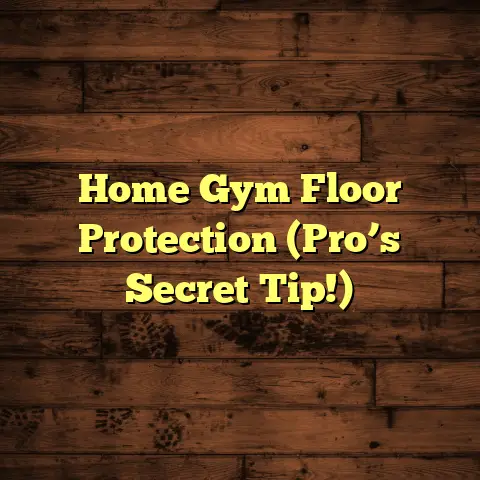Fix Garage Floor Cracks: Pro Tips (4 Fix Now!)
And I’m here to talk about something near and dear to my heart, and probably under your car: your garage floor!
Now, you might be thinking, “Garage floor? What’s the big deal?”
Well, let me tell you, a well-maintained garage floor is more important than you might think, especially if you’re a pet owner.
Think about it: our furry friends explore every nook and cranny of our homes, including the garage.
Cracks and uneven surfaces can be a real hazard, leading to scrapes, trips, or even more serious injuries.
I’ve seen it happen, and it’s not pretty.
That’s why I’m sharing my top tips for addressing and fixing those pesky garage floor cracks.
Let’s dive in and make your garage a safer place for everyone, including your beloved pets!
Section 1: Understanding Garage Floor Cracks
So, what are we dealing with here? Not all cracks are created equal.
Let’s break down the different types of cracks you might find in your garage and what causes them.
1.1 Types of Cracks
Okay, picture this: you’re inspecting your garage floor.
What do you see? Here are a few common types of cracks:
-
Hairline Cracks: These are those tiny, barely visible cracks. They’re usually less than 1/16 inch wide. Often, they’re more of an aesthetic issue than a structural one.
-
Surface Cracks: These are a bit wider than hairline cracks, usually up to 1/8 inch. They’re often caused by surface shrinkage of the concrete.
-
Structural Cracks: Now, these are the ones that can cause real concern. They’re typically wider than 1/8 inch. They can indicate underlying issues with the foundation. These might be accompanied by unevenness or displacement of the concrete.
-
Settlement Cracks: These often appear soon after a home is built. They are caused by the ground settling beneath the foundation. They can be diagonal or stair-step shaped.
What causes these cracks, anyway?
Well, a few things:
-
Temperature Fluctuations: Concrete expands and contracts with temperature changes. Over time, this can lead to cracks. I’ve seen this happen a lot in areas with harsh winters and hot summers.
-
Moisture Infiltration: Water seeping into the concrete can cause it to weaken and crack. This is especially true if the water freezes and expands.
-
Heavy Loads: Parking heavy vehicles or storing heavy items in your garage can put stress on the concrete. This can lead to cracks over time.
According to the Portland Cement Association, concrete’s compressive strength can be reduced by up to 50% when subjected to sustained heavy loads over long periods.
-
Poor Installation: If the concrete wasn’t properly mixed or poured, it can be more prone to cracking.
1.2 The Impact of Cracks on Pets
Alright, so we know what causes the cracks.
But how do they affect our furry friends?
Here’s the deal:
-
Tripping Hazards: Uneven surfaces and wide cracks can be tripping hazards for pets, especially older ones or those with mobility issues. I’ve seen dogs take a tumble because of a crack they didn’t see.
-
Cut Paws: Sharp edges of cracks can cut or scrape your pet’s paws. Imagine your dog running around in the garage and getting a nasty cut – not fun!
-
Getting Stuck: Small animals, like cats or small dogs, can sometimes get their paws or claws stuck in narrow cracks. This can cause panic and potential injury.
-
Ingesting Debris: Cracks can accumulate dirt, dust, and even small pieces of loose concrete. Pets might lick or ingest these, which can lead to digestive issues.
I remember one time, a client’s cat got its claw stuck in a crack.
It was a frantic scene, and we had to carefully extract the claw without causing further injury.
It was a good reminder of how important it is to keep those cracks in check!
Section 2: Pro Tip 1 – Identifying the Cause of Cracks
Okay, time to put on your detective hat!
Before you start patching things up, you need to figure out what’s causing those cracks in the first place.
2.1 Inspection Techniques
Here’s how I approach inspecting garage floor cracks:
-
Grab Your Gear: You’ll need a few tools:
-
Bright Light: A strong flashlight or work light is essential for seeing the cracks clearly.
-
Magnifying Glass: This will help you examine the cracks up close.
-
Ruler or Measuring Tape: To measure the width and length of the cracks.
-
Crack Depth Gauge (Optional): This tool can help you determine the depth of the crack.
-
Camera: Take photos of the cracks from different angles. This will help you track their progress over time.
-
-
Clean the Area: Sweep or vacuum the garage floor to remove any dirt or debris that might be obscuring the cracks.
-
Examine the Cracks:
-
Width: Measure the width of the cracks at different points. Note any areas where the cracks are wider or narrower.
-
Length: Measure the length of the cracks.
-
Depth: If you have a crack depth gauge, use it to determine the depth of the cracks.
-
Pattern: Observe the pattern of the cracks. Are they random, straight, or branching?
-
Location: Note where the cracks are located in relation to walls, drains, or other features.
-
Displacement: Check for any vertical displacement (unevenness) along the cracks. This can indicate a more serious structural issue.
-
-
Document Your Findings: Write down all your observations, measurements, and photos. This will be helpful when you’re deciding on the best course of action.
2.2 Assessing the Impact on Pets
Now, let’s think like a pet owner. How do these cracks affect your furry friend?
-
Observe Your Pet: Spend some time watching your pet in the garage. Do they seem hesitant to walk in certain areas? Are they limping or favoring a paw? Do they sniff or lick the cracks?
-
Check Their Paws: Regularly inspect your pet’s paws for any cuts, scrapes, or irritation.
-
Consider Their Age and Mobility: Older pets or those with mobility issues are more vulnerable to injuries from cracks.
-
Use Your Imagination: Try to imagine what it would be like to walk on the garage floor with bare paws. Are there any areas that seem particularly hazardous?
If you notice any of these signs, it’s a good idea to address the cracks as soon as possible.
Section 3: Pro Tip 2 – Quick Fixes for Minor Cracks
Alright, let’s get to work! For minor cracks, you can often tackle the repairs yourself with a few simple tools and materials.
3.1 Materials Needed
Here’s what you’ll need for repairing minor cracks:
-
Concrete Crack Filler: Choose a product specifically designed for filling concrete cracks.
I recommend looking for a self-leveling, flexible filler that’s resistant to water and chemicals.
Pet-Safe Options: Look for fillers that are low-VOC (volatile organic compounds) and non-toxic.
Some good options include:
- Sakrete Concrete Crack Filler: A popular and reliable choice.
- DAP Concrete Patch: Easy to apply and quick-drying.
- Quikrete Advanced Polymer Concrete Crack Sealant: Excellent for sealing cracks and preventing water damage.
-
Wire Brush: For cleaning out the cracks.
-
Vacuum Cleaner: To remove any loose debris.
-
Putty Knife or Trowel: For applying the crack filler.
-
Gloves: To protect your hands.
-
Safety Glasses: To protect your eyes.
-
Damp Sponge: For cleaning up any excess filler.
3.2 Step-by-Step Repair Process
Here’s how I approach repairing minor cracks:
-
Prepare the Area:
-
Clean the cracks thoroughly with a wire brush to remove any loose debris.
-
Vacuum out the cracks to remove any remaining dust or dirt.
-
Make sure the area is dry before proceeding.
-
-
Apply the Crack Filler:
-
Follow the manufacturer’s instructions for applying the crack filler.
-
Typically, you’ll want to squeeze the filler into the crack, making sure to fill it completely.
-
Use a putty knife or trowel to smooth out the surface of the filler and make it flush with the surrounding concrete.
-
-
Clean Up:
- Use a damp sponge to wipe away any excess filler from the surrounding concrete.
-
Cure the Filler:
- Allow the filler to cure completely according to the manufacturer’s instructions. This may take several hours or even days.
Safety Precautions for Pets:
-
Keep Pets Away: Keep your pets away from the repair area while you’re working and while the filler is curing.
-
Ventilation: Make sure the garage is well-ventilated to minimize exposure to any fumes from the filler.
-
Clean Up Thoroughly: After the filler has cured, sweep or vacuum the area to remove any loose debris.
3.3 Maintaining a Pet-Friendly Environment
While you’re repairing the cracks, it’s important to keep your garage pet-friendly. Here are a few tips:
-
Barriers: Use barriers or temporary enclosures to keep your pets away from the repair area.
-
Alternative Space: Provide your pets with a comfortable alternative space to hang out while the repairs are being done.
-
Supervision: If your pets must be in the garage, supervise them closely to prevent them from getting into trouble.
Section 4: Pro Tip 3 – Addressing Larger Cracks
Okay, so what if you’re dealing with larger, more serious cracks?
4.1 When to Seek Professional Help
Sometimes, DIY just isn’t enough. Here are some signs that indicate a crack is too severe for a DIY fix:
-
Width: Cracks wider than 1/4 inch.
-
Depth: Cracks that are very deep or extend all the way through the concrete slab.
-
Displacement: Significant vertical displacement (unevenness) along the cracks.
-
Multiple Cracks: A large number of cracks in a small area.
-
Underlying Issues: Signs of underlying structural problems, such as foundation settlement or water damage.
If you see any of these signs, it’s best to call in a professional.
Finding Reputable Professionals:
-
Ask for Recommendations: Ask friends, family, or neighbors for recommendations.
-
Check Online Reviews: Read online reviews of local flooring contractors.
-
Get Multiple Quotes: Get quotes from several different contractors before making a decision.
-
Verify Credentials: Make sure the contractor is licensed and insured.
-
Ask About Experience: Ask the contractor about their experience with garage floor repairs.
4.2 DIY Solutions for Larger Cracks
If you’re feeling ambitious and the cracks aren’t too severe, you can try repairing larger cracks yourself using epoxy or concrete resurfacing techniques.
Epoxy Repair:
-
Prepare the Crack:
-
Widen the crack with a chisel and hammer to create a V-shaped groove.
-
Clean the crack thoroughly with a wire brush and vacuum.
-
Apply a concrete bonding agent to the inside of the crack.
-
-
Mix the Epoxy:
- Follow the manufacturer’s instructions for mixing the epoxy.
-
Apply the Epoxy:
-
Pour the epoxy into the crack, filling it completely.
-
Use a trowel to smooth out the surface of the epoxy and make it flush with the surrounding concrete.
-
-
Cure the Epoxy:
- Allow the epoxy to cure completely according to the manufacturer’s instructions.
Concrete Resurfacing:
-
Prepare the Surface:
-
Clean the garage floor thoroughly with a pressure washer.
-
Repair any existing cracks or damage with concrete patch.
-
Apply a concrete bonding agent to the entire floor.
-
-
Mix the Resurfacer:
- Follow the manufacturer’s instructions for mixing the concrete resurfacer.
-
Apply the Resurfacer:
-
Pour the resurfacer onto the floor and spread it evenly with a squeegee or trowel.
-
You may need to apply multiple coats to achieve the desired thickness.
-
-
Cure the Resurfacer:
- Allow the resurfacer to cure completely according to the manufacturer’s instructions.
Important Considerations:
-
Drying Time: Allow sufficient drying time for the epoxy or resurfacer before allowing pets or vehicles on the floor.
-
Keep Pets Away: Keep pets away from the area during the repair process and while the materials are curing.
Section 5: Pro Tip 4 – Preventive Measures
Alright, let’s talk about preventing those cracks from coming back!
5.1 Regular Maintenance
Regular garage floor maintenance is key to preventing future cracks.
Here are some tips:
-
Clean Regularly: Sweep or vacuum your garage floor regularly to remove dirt, dust, and debris.
-
Clean Spills Immediately: Clean up any spills of oil, grease, or chemicals immediately to prevent them from damaging the concrete.
-
Use a Sealer: Apply a concrete sealer every few years to protect the concrete from water and chemicals.
Pet-Safe Sealers: Look for sealers that are low-VOC and non-toxic.
-
Avoid Heavy Loads: Avoid parking heavy vehicles or storing heavy items in your garage if possible.
-
Check for Cracks Regularly: Inspect your garage floor regularly for any new cracks or damage.
5.2 Choosing Pet-Friendly Flooring Options
If you’re planning to replace your garage floor, consider choosing a flooring material that’s more resilient to cracking and safe for pets.
Here are a few options:
-
Epoxy Flooring: Epoxy flooring is durable, chemical-resistant, and easy to clean. It’s also available in a variety of colors and styles.
Pros: Durable, easy to clean, chemical-resistant.
Cons: Can be slippery when wet, can be expensive.
-
Rubber Flooring: Rubber flooring is slip-resistant, comfortable to walk on, and easy to clean. It’s also a good option for absorbing impact.
Pros: Slip-resistant, comfortable, easy to clean.
Cons: Can be expensive, may not be as durable as epoxy.
-
Concrete Tiles: Concrete tiles are durable, slip-resistant, and available in a variety of styles.
Pros: Durable, slip-resistant, stylish.
Cons: Can be expensive, can be difficult to install.
When choosing a flooring option, consider your budget, your needs, and your pet’s safety.
Conclusion
So, there you have it! My top tips for fixing garage floor cracks and keeping your pets safe.
Remember, addressing garage floor cracks is not just about aesthetics; it’s about creating a safe and healthy environment for your furry companions.
By taking proactive steps to maintain your garage floor, you can prevent injuries, protect your pets, and enjoy a happier home for everyone.
Don’t wait until a crack becomes a major problem.
Inspect your garage floor regularly, address any issues promptly, and choose pet-friendly flooring options when possible.
Your pets will thank you for it!
And hey, if you ever need a hand with your garage floor, don’t hesitate to give me a call. I’m always happy to help!




